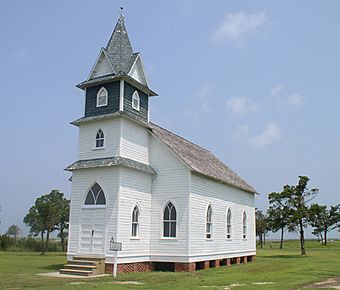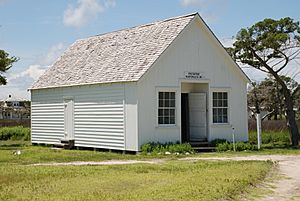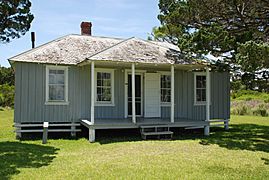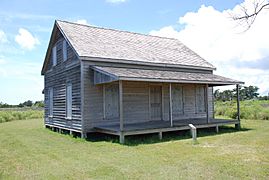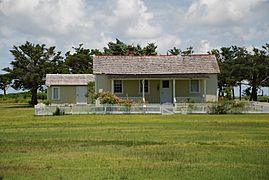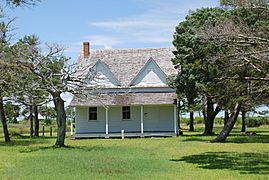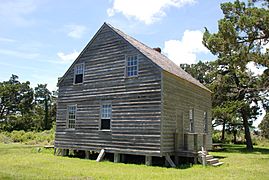Portsmouth, North Carolina facts for kids
Portsmouth was once a busy fishing and shipping village. It was located on Portsmouth Island in the Outer Banks of North Carolina, United States. Portsmouth Island is a special island that is usually connected to the northern part of the North Core Banks. It sits across Ocracoke Inlet from the village of Ocracoke.
The town is in Carteret County. It was started in 1753 by the North Carolina Colonial Assembly. People lived there until 1971. Today, what's left of Portsmouth Village is part of the Cape Lookout National Seashore.
Contents
A Look Back: Portsmouth's History
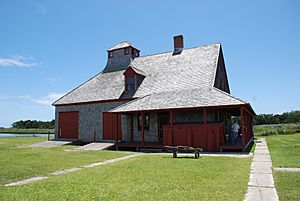
In the old days, Ocracoke Inlet was a very popular route for ships. Portsmouth was set up in 1753 as a "lightering port." This meant big ocean ships would transfer their heavy cargo here. Smaller boats could then carry the goods through the shallow waters of Pamlico and Core Sounds.
Portsmouth grew quite a lot. By 1860, about 685 people lived there. Even though it was small, Portsmouth was one of the most important entry points along the Atlantic coast after the American Revolution.
Challenges and Decline
Things started to change for Portsmouth in 1846. Two strong hurricanes created new inlets, like Oregon Inlet. They also made Hatteras Inlet deeper. This made Ocracoke Inlet less popular for ships. Also, the water around Portsmouth's harbor started to get too shallow. This made it harder for boats to come and go.
The American Civil War also hurt the village. Many people left for the mainland when Union soldiers came to the Outer Banks. A lot of them never came back after the war. The village continued to shrink, and hurricanes made things worse. A huge hurricane season in 1933 was another big event that people remembered as a sign of the island's decline.
More bad news came when the U.S. Life-Saving Station closed in 1937. The post office also shut down in 1959. By 1967, the National Park Service bought Portsmouth Island and the village. It became part of the new Cape Lookout National Seashore. The last two older residents, Marian Gray Babb and Nora Dixon, left the island in 1971. This happened after Henry Pigott, who helped take care of them, passed away.
In 1978, Portsmouth Village was added to the National Register of Historic Places. This means it's a special place worth protecting.
Life in Portsmouth Village
The people of Portsmouth Village mostly worked in fishing and other jobs related to the sea. They were pilots for ships and helped man vessels. They even built a small island called Shell Castle out of oyster shells to use as a shipping spot. Later, many became fishermen and clammers.
Many of Portsmouth's residents were African American. Their families had been brought to the island long ago. After the Civil War, most African Americans left Portsmouth. However, some families stayed, like the Pigott family. Henry and Lizzie Pigott, who were descendants of this family, were among the last people to live on the island.
During a time when laws kept Black and white people separate (called segregation), children of different races could not go to the same one-room schoolhouse on Portsmouth Island. The state never built a separate school for Black children. So, African Americans who stayed on the island in its later years did not get a formal education.
Life on the island was simple. People lived without electricity, running water, or refrigerators.
Portsmouth Today
Today, 21 buildings still stand in Portsmouth Village. This includes about a dozen homes and some smaller buildings. These are kept up as part of the Portsmouth Village Historic District.
Some of these buildings are open for visitors in the summer. These include the Salter House (which is now a visitor center), the old one-room school, the Methodist Church, the Life-Saving Station, Henry Pigott's house, and the Post Office/general store.
Many people visit the island today, especially in the summer. They often camp overnight on the beach. Camping is not allowed inside the village itself. Facilities are very basic. There's a compost toilet near the Life-Saving Station and a restroom in the Salter House. However, there is no drinking water, food, or electricity available.
- Historical buildings in the village
Portsmouth Homecoming Event
Portsmouth is famous for its "homecoming" event, which happens every two years. This tradition started with families who had left the island before the 1960s. They would come back to visit. It was first connected to the Methodist and Primitive Baptist churches, especially from Cedar Island, North Carolina, where many former Portsmouth residents had moved.
The homecoming began as a church and family gathering. But now, it's more of a general celebration of Portsmouth's history. The National Park Service helps organize it. Many people who don't have direct family ties to the island also come to the homecoming.
How to Get to Portsmouth
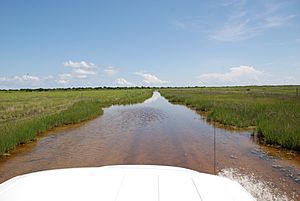
You can reach Portsmouth by taking a passenger ferry from Ocracoke village. You can also get there with four-wheel-drive vehicles. These vehicles cross Core Sound by ferry from Atlantic. Then, they use the beach and tracks on North Core Banks.
Portsmouth Island Geography
Portsmouth Island is located east of North Core Banks. It's usually connected to North Core Banks when the tide is low. The exact edges of the island aren't always clear and have changed over time. Older maps used the name for the island between Ocracoke Inlet and Whalebone Inlet. Whalebone Inlet closed in 1961, and that area is now the northern end of North Core Banks.
Weather and Nature
Portsmouth, North Carolina, has a warm, wet climate. Summers are hot and humid, and winters are cool. It rains throughout the year. In summer, a cool sea breeze often blows in the afternoon. However, it can get extremely hot and humid sometimes.
Portsmouth can be hit by hurricanes, especially from June through November. The busiest time for hurricanes is late August and September. In winter, it can get cold and windy.
The plants in Portsmouth are mostly Live oak trees and Sea Oats. The area is like a coastal Prairie.


